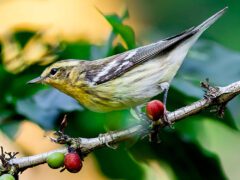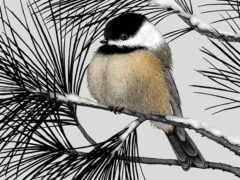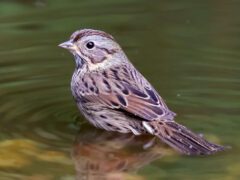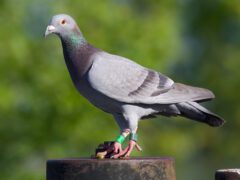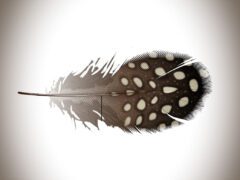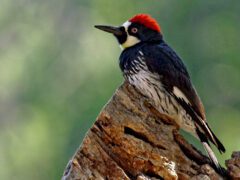Black-bellied Plover Similar Species Comparison
Main SpeciesBlack-bellied Plover
Breeding male
Heavy-bodied shorebird with a short, thick neck and a stubby bill. Breeding males have a black belly and a mottled black-and-white back.
© Matt Davis / Macaulay LibraryCalifornia, May 02, 2017Nonbreeding adult
Heavy-bodied shorebird with a short, thick neck and a stubby bill. Nonbreeding birds have variable amounts of brownish mottling on the back and a smudgy face and breast.
© Bridget Spencer / Macaulay LibraryCalifornia, November 23, 2019Breeding male
Males and females equally share the responsibility of nest incubation, which usually lasts from the end of May to the end of June.
© Benjamin Clock / Macaulay LibraryAlaska, June 05, 2009Juvenile
Short-necked shorebird with a stubby bill. Juveniles have a crisply marked salt-and-pepper look to them with a streaked breast.
© Brendan Fogarty / Macaulay LibraryNew York, September 20, 2020Juvenile
In flight, all ages show distinctive black armpits. Note mostly white tail.
© Dorian Anderson / Macaulay LibraryCalifornia, October 31, 2020Nonbreeding adult
During the nonbreeding season on the Atlantic Coast, Black-bellied Plovers forage for larger prey items such as marine worms, bivalves, and shrimp.
© Benjamin Clock / Macaulay LibraryNew Jersey, January 24, 2009Juvenile
Juveniles have a salt and pepper look to them with a streaked breast.
© Petra Clayton / Macaulay LibraryCalifornia, October 22, 2016Juvenile with Killdeer
Commonly forages on lake shores or flooded agricultural fields during migration.
© Jay McGowan / Macaulay LibraryNew York, September 17, 2015Nonbreeding adult
Heavy-bodied shorebird with a short, thick neck and a thick but stubby bill. Nonbreeding birds have variable amounts of brownish mottling on the back and a smudgy face and breast.
© Michael Warner / Macaulay LibraryFlorida, February 24, 2017Breeding male
Black-bellied Plovers perform distraction displays including running, faking wing injuries, and head bowing to draw a predator's attention toward themselves and away from the nest.
© Benjamin Clock / Macaulay LibraryAlaska, June 05, 2009Habitat
During migration and winter found on beaches, estuaries, lake margins, and flooded pastures.
© Ben Leff / Macaulay LibraryFlorida, March 26, 2017Similar SpeciesAmerican Golden-Plover
Nonbreeding adult
Nonbreeding American Golden-Plovers are brighter overall than nonbreeding Black-bellied Plovers with a more obvious white eyebrow. Nonbreeders also tend to have dingier underparts than Black-bellied Plovers.
© Ronald Newhouse / Macaulay LibraryTexas, April 07, 2016Similar SpeciesAmerican Golden-Plover
Juvenile
Juvenile American Golden-Plovers often have golden tipped feathers and a darker cap that Black-bellied Plovers.
© Luke Seitz / Macaulay LibraryNew Hampshire, September 27, 2011Similar SpeciesAmerican Golden-Plover
Breeding female
Breeding female American Golden-Plovers are more golden overall than breeding Black-bellied Plovers.
© Ian Davies / Macaulay LibraryAlaska, June 29, 2013Similar SpeciesAmerican Golden-Plover
Breeding male
Breeding male American Gold Plovers have a mottled back with golden tones that are lacking on Black-bellied Plovers. Also note the cap is darker than Black-bellied.
© Ian Davies / Macaulay LibraryAlaska, June 19, 2012Similar SpeciesPacific Golden-Plover
Nonbreeding
Nonbreeding Pacific Golden-Plovers most often (but not always) show golden spots on the back and a pale yellow wash on the face that Black-bellied Plovers lack.
© Jacob Drucker / Macaulay LibraryHawaii, February 20, 2016Similar SpeciesPacific Golden-Plover
Breeding female
Breeding female Pacific Golden-Plovers have a mottled back with golden hues that Black-bellied Plovers lack.
© Ian Davies / Macaulay LibraryAlaska, May 22, 2013Similar SpeciesPacific Golden-Plover
Breeding male
Pacific Golden-Plovers have golden tipped feathers and a darker crown that Black-bellied Plovers lack.
© Brian Sullivan / Macaulay LibraryAlaska, May 07, 2011Compare with Similar Species
Click on an image to compare
Species in This Family
Plovers and Lapwings(Order: Charadriiformes, Family: Charadriidae)
More to Read
Don't miss a thing! Join our email list
The Cornell Lab will send you updates about birds,
birding, and opportunities to help bird conservation.











